Clinical Professor, Dr. Michael Rekart, worked in a MSF Ebola case management centre in Sierra Leone. Here are his messages from the front lines of the Ebola crisis.
Back in Vancouver, I am comfortably ensconced in my living room listening to alternative music and drinking hot chocolate. I’ve done all the stuff I usually do when I first get back from a mission: I had a good sleep, a long shower, unpacked, went to Tim Horton’s and texted my son, Eddy. I have replenished my fridge, my wine rack and my snack shelf.
My departure from Sierra Leone with 3 other Canadian expats was uneventful. Our Royal Air Maroc plane left on time at 5am Sunday and the 3 hour layover in Casablanca was not too bad. After arriving in Amsterdam late Sunday afternoon, Alex and I visited a coffee shop before we wolfed down pad thai and som tum at a pleasant Thai café that was actually run by Thais. The Monday debriefing at the MSF Holland office was fine. The Ebola medical coordinator seemed interested in my observations on Ebola interventions. The MSF staff health physician concluded that I had had ‘no breaks in PPE’ and that I was, therefore, low risk for infection. She also discussed their expectations for my 21-day self-quarantine period – no surprises. I spent 30 minutes (as required) with the MSF psychosocial counselor. I managed to keep quiet long enough for her to start talking first. She proceeded to tell me about her Masters thesis on arachnophobia. Battle won!
I flew out of Amsterdam Tuesday afternoon and I had a brief layover at Lester B. Pearson Airport in Toronto. There, a public health nurse interviewed me about my Ebola risk. We filled in a few forms, my temperature was taken and she agreed that I was low risk. The official term on the Public Health Agency of Canada form is ‘at risk of developing symptoms’ as opposed to ‘at higher risk of developing symptoms’, or the even worse designation ‘exhibiting symptoms consistent with Ebola virus disease’. I was ordered to check in with the Vancouver Health Department within 24 hours and I flew on to Vancouver in a WestJet Plus seat. That was nice touch.
But, this missive is about Abigail not me. I have struggled with whether it is important to tell Abigail’s story because I don’t want to recount her sad and short tale for self-serving reasons. I decided it is important.
I first saw her, unexpectedly, one afternoon while making ICU rounds. She was lying curled up in bed #14 just beyond the end of the plexiglass corridor that juts three-quarters of the way down the middle of the ICU. The corridor allowed us to monitor patients without being in PPE. We couldn’t do anything ourselves but we could give directions to staff that might already be inside. And, it was reassuring to be able to check on patients. It was about a week before my departure. I had not admitted Abigail so I don’t know her full story, only her last week. Abigail is not even her real name. I misunderstood the response of a national nurse when I asked her first name. But, she will always be Abigail to me.
Abigail was 12 years old but, like so many Sierra Leonean children, she appeared much younger, more like 8 or 9 years old. She was obviously malnourished and stunted even before she got Ebola. Her hair was in braids, her clothes were tattered and she always seemed to be shivering. She was clearly dehydrated and we tried to keep an IV in her but did not always succeed. Abigail had several troubling Ebola symptoms and signs that I won’t list. Suffice it to say, she was very sick. Despite her pain and suffering, she always said “I’m fine” when we asked how she felt. I don’t know if she had been raised not to complain or if she just wanted to left alone.
During my last high-risk entry early Saturday morning, I stopped at Abigail’s bed after seeing the other children. Curled up and shivering, she was more dehydrated than usual and I decided that it was critical for her to receive IV fluids. I wish I could say that I then deftly inserted an intravenous cannula, but it was actually nurse Joseph that did that after I failed twice. Joseph and I stayed by her bedside as long as we could to ensure that she got a bolus of fluid and that her IV was secure.
I left the EMC hoping that she would hold on for a few more days. I always felt that the longer someone stayed alive the better their chances. But that evening at dinner, Dr. Philippe told me that Abigail died after I left. I wish he had stopped there but he proceeded to tell me her last words. In English, Abigail said “help me”.
The end.
Blowin’ in the wind
The time as I write this last missive from Sierra Leone is 2am on Saturday morning and I am preparing to enter the high-risk zone for one last time. I want to see all of the children again on the off chance that I can do something for one of them. Except for the damned mosquitoes, the EMC is remarkably quiet tonight after only six admissions, three discharges and one death earlier today. There are eight remaining ICU patients, including three children, but incredibly none actually have or require an intravenous line at the moment. They are all tolerating oral fluids. To my utter amazement, the young woman that I admitted in a coma two days ago is awake, alert, and being discharged tomorrow. No, my swift and decisive action did not save her life from a dramatic and rapidly advancing infection like meningitis or cerebral malaria. Her problem was certainly more common and arguably more tragic. She was beaten into unconsciousness by her ‘boyfriend’ and left to die.
I have had a bit of time to reflect on my experience with Ebola and Sierra Leone. The people here are lovely, caring, and remarkably cheerful given their difficult lot in life. The weather has been tolerable most of the time but I’m glad that my departure precedes the hot and rainy season. My expat colleagues are compassionate, committed, and hard working. Most of them are also very young. The food has been filling but not very tasty but I do love the groundnut stew. However, I am growing tired of instant Nescafe with powdered milk… yuk! And, if I never see chlorine again, it will be too soon.
I think that I have learned about Ebola. It really is not a very complex or complicated disease. But, it is impressive that a tiny filamentous virus with only 6 proteins has such a high mortality rate. The patients that I have seen have fallen into fairly well defined groups according to their signs and symptoms. For many, the gastrointestinal system seems to have been specifically targeted resulting in an illness characterized by vomiting and diarrhea. These patients get dehydrated, cannot tolerate oral medications and seem to benefit from IV fluids. For others, neurological symptoms and signs dominate the clinical picture and these patients are prone to confusion, disorientation, combativeness, and wandering around the complex or moving from bed to bed. I generally avoid IVs for these kinds of patients because they are prone to pulling them out and contaminating their surroundings with blood. Still others present with profound weakness. I once admitted a strapping 40 year old carpenter who had to be carried into triage by two of his brothers because he could hardly move a muscle after only two days of illness. I was somewhat skeptical when I first heard patients complain of profound and debilitating weakness. But, now I am convinced that it is real.
Age is clearly an important prognostic factor in most studies and in my own experience. The elderly and the very young do poorly. Pregnant women also seem to be affected more severely. The results of the Ebola blood test can be predictive since this reflects the plasma viral load. Of course, a higher viral load results in a higher mortality rate. Hiccups are a unique symptom in Ebola Virus Disease, but I have not found them predictive of the outcome. Finally, bleeding is certainly a bad sign. Ebola is a haemorrhagic fever after all. But, the bleeding problems seem to come late in the course of the disease, as a terminal manifestation rather than an aid to diagnosis.
I hope that I have also learned a little bit about managing Ebola patients. An Ebola epidemic is perhaps the epitome of a population-wide emergency. But, when managing an individual Ebola patient, I have found the adage to be true – “there are no emergencies in Ebola”. As with the tortoise and the hare, slow and steady wins the race. Quick and aggressive action can result in an increased risk to health care workers and seldom changes the course of the illness for the patient. The systematic provision of basic supportive care is the most important thing we can do. Food, fluids, antipyretics, anti-emetics, pain relief, oral replacement salts (ORS), caring, and psychosocial support are the keys to fighting this virus.
Watching young children die is the thing I hate the most. Once they have passed away, the tragedy itself has happened and the grieving can start. I guess they call that closure. But, watching life gradually leave a lonely child is hell. They grab your arm and stare up at you with clenched teeth and pleading eyes. I know that most of them are confused and delirious, but their faces betray their terror. And, morphine is all we can offer.
Get the hell out of town
My last day shift was calm. Most of our really sick patients have passed away and there have been few admissions in the last couple of days. We had fifty-three patients on Sunday, but that number decreased to below thirty by Thursday. This might be just a statistical blip, but I do not think so. The district surveillance officer told me that cases in all of Sierra Leone are on the decline. Yesterday, there were apparently only twenty-three new Ebola diagnoses in the entire country. Hopefully, this reflects a fading epidemic, but it is probably too early to tell. Ebola can get the hell out of town and never come back, as far as I am concerned.
Some people think that the Sierra Leone Ebola quarantine system may be hiding new cases. When someone dies from Ebola or calls the Ebola hotline with suspicious symptoms, their house is often blocked off for 21 days or more behind a 24-hour police guard. This means that no one can enter or leave, even for work or medical care. The government is supposed to provide food and water during the quarantine period but this apparently doesn’t always happen. If the quarantine house is attached to other houses or part of a row of houses, as is common in Freetown, all of the attached houses are quarantined. This may actually increase the spread of Ebola and other infectious diseases and it also makes people reluctant to call the hotline or report a death.
Tomorrow, I will sleep in a little bit, collect my passport and air ticket and work the night shift one last time. Then, I will have Saturday off to recover from my 12-hour night shift, pack and say my goodbyes before boarding the boat to the airport at 11pm for my departing flight at 5am on Sunday morning. Strange they would build an international airport on a peninsula across a long waterway from the capital city. Only a couple of intentional airlines still fly in and out of Sierra Leone. MSF uses Air Brussels and Royal Air Maroc (RAM). I am booked on RAM, which means a 5-hour stopover in the Casablanca. That may sound exotic. but in fact the Casablanca airport transit lounge is old, hot, and dirty, with most shops closed. On Saturday evening before I depart, I will meet up with a good friend from Bo who was with me at the Ebola training in Amsterdam and during my three weeks at Bo. He is a 30’ish Watsan (Water & Sanitation Officer) from Montreal. For some reason, we hit it off. We will debrief in Amsterdam on Monday, December 19th and I will head back to Vancouver on the 20th.
I am not sure what to expect when I arrive in Canada. If the re-entry restrictions for returning Ebola fighters have not changed, a British Columbia (BC) public health officer who will assess my risk of Ebola will greet me at the airport. If I have had a documented high risk exposure like a needle stick accident, I will need to say at home where I will receive a daily visit from the health department for a temperature and symptom check. If I have had no such exposure, I will be permitted to self-quarantine at home. I will take my own temperature every day and report it to the health department by phone. But, I can go about my normal activities except for seeing patients. I can go out to movies or the pool or to my UBC office as long as I do not have a fever before I leave, and I take my temperature when I return. If I do not have a fever before or after such an excursion, the people that I might have contacted will not need to be traced if I do develop a fever later on. But, if the BC regulations have changed, they have probably become more restrictive. Thank God I am not returning to the USA where the restrictions are inconsistent, complicated, and based on fear and politics rather than fact and reason.
My last patient yesterday was a 24-year old woman who arrived from a quarantine house in a coma. I managed to place an intravenous cannula and I quickly gave her a bolus of 500ml of Ringers Lactate before administering intravenous doses of an antibiotic (Ceftriaxone), an anti-malarial (Artusenate), and an antipyretic (Paracetamol). She seemed to perk up a little bit by the time I went home last night and the nurses told me that they sat her up and fed her today! I just checked in on her (from 5 metres away) and she seemed to be sleeping. She is Ebola and malaria negative so I am not sure of her diagnosis, but perhaps hers will be one life that I can be pretty sure I have saved.
I was very pleased to leave the EMC today walking between the Pangura brothers, 10 year old Peter and 12 year old Paul. They were skinny, unsteady and weak but Ebola-free. Sometimes, I forget that over half of our Ebola patients do survive. However, both of their parents succumbed to Ebola and the boys do not yet know. When someone is declared Ebola cured, all of their possessions are burned, they have a shower and they are given new clothes. As they walk from the high-risk zone through the low-risk zone to the EMC exit, this is the only time we can be sure they are not an Ebola risk to us. That means we can actually touch them. I very much enjoyed high-fiving the Bangura boys as they left. And, it suddenly occurred to me that I had not touched anyone for 7 weeks.
Death in the afternoon
The deaths are starting to get to me. We’ve had fourteen of these in the last six days and many were children and infants. Our Ebola treatment facility at Prince of Wales (POW) School has become a common referral destination for babies, small children, and pregnant women with Ebola. It seems that the other Ebola centres are uncomfortable dealing with these difficult and very high-risk patients and so they are sending them to POW. I firmly believe that these cases are better off with us, but it increases our workload, our stress level, and ultimately our case fatality rate. Placing intravenous cannulas in tiny infants is intricate and you cannot really get a very good read on the clinical situation. Obviously, they cannot tell you how they are feeling.
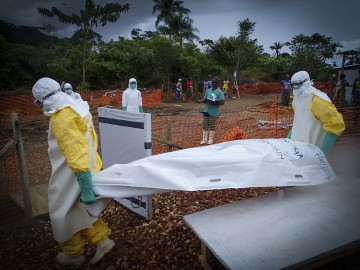
MSF staff hand over a body to an IFRC burial team at MSF’s Case Management Centre in Kailahun, Sierra Leone. ©Fabio Basone, MSF
Ebola babies are especially difficult. They can appear quite normal, even chubby, and they seem to feed, cry, cuddle, and move around like a healthy infant for several days. And then, all of a sudden, they just die. Yesterday, a 3-month old girl and a 1-year old boy whose beds were side-by-side died within four hours of each other. The little boy was clearly in bad shape for the entire hospitalization, but the girl looked entirely well. We had even transferred her to the convalescent tent for a while so she could be fed and cared for by two lovely female survivors (a 30-year old lady and her mother-in-law) who extended their stay for this purpose. After they were finally discharged, we moved her into the ICU tent so that she could be better observed and we brought in another female survivor to be her caretaker. All of this was to no avail. She was avidly taking milk one minute and gone the next. I had to pronounce both children dead.
The boy’s father was called and he promptly came to POW for the bad news. I had to tell him that his little boy was another victim of Ebola and he was inconsolable. The boy was so sick for the entire time that the young, well-educated, and obviously caring father could not even visit him. I had dreaded this duty because I had done the same with 9-year old Fatmata’s aunt a few days earlier. Poor thing, she really never had a chance. Her mother had died of Ebola on Boxing Day and the aunt pleaded with me to save her brother Abdulla because he was the only remaining child in the family. But, Abdulla unfortunately had to witness Fatmata’s passing since he was in the adjoining bed. He went rapidly downhill from that point and died a week later. Abdulla and I often joked about football and his favorite player, Lionel Messi. I even thought about sending Messi an email asking for a supportive message to Abdulla. And, now it’s too late. Abdulla is dead.
Ebola is a liar. Unexpected and unexplained deaths in Ebola are not infrequent even in adults. Last week, two men who were being prepared for discharge suddenly gave their last breath. One fell dead to the ground on his way back to his bed after receiving visitors and the other was found in the bathroom. Sometimes, I find it hard to go to work in the morning. I look forward to seeing improvement in my patients and occasionally I see children with happy and grateful smiles on their faces. I know that a select few will survive and live a normal life. But, I also know that 4 out of 10 will end up in a nonporous white body bag with their name and their MSF Ebola number boldly inscribed on the outside by a permanent magic marker. I will never be able to erase this image from my mind and I hope the world remembers too.
This is such a pity
The MSF-Geneva EMC is located within the expansive grounds of a private school named Prince of Wales (POW) that abuts the Atlantic Ocean but has been shut down by Ebola. In fact, all schools in Sierra Leone are closed. The EMC set-up, materials and structures (e.g. Rubhalls and Triganos) are similar to Bo, but the operation itself differs in several important aspects. One difference is that whereas Bo accepts mainly transfers that have already been confirmed to have Ebola, POW receives patients in different ways. Patients can also be sent to POW in ambulances direct from the community if they call the Ebola hotline (#117) and report suspicious symptoms, or if they have been quarantined in their houses because of a high-risk exposure such as the death of a close relative. Finally, people can walk-in to the POW facility if they are worried that they might have Ebola. All patients come first through the triage area.
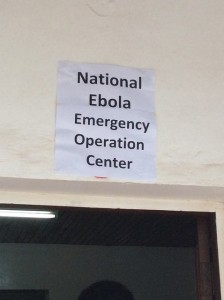
Sierra Leone National Ebola Emergency Operations Center at WHO Country Office Headquarters. Photo: ©Jennifer Brooks
Another key difference is that the patient number in POW is growing while the patient number in Bo is declining. When I left Bo, there were twelve patients; when I arrived at POW, there were forty-six. Because of this and other factors, the workload for expats at POW is much greater. When I arrived, everyone was leaving the hotel at 6:15 am and arriving back exhausted at 9 pm. Fortunately, Greg and I expanded the expat physician team by 40% so we now have a schedule that is somewhat more reasonable but still heavy. We all still work 12 hours a day but our workload is now split up among triage, night shift (7pm-7 am), the IV team, confirmed EVD patients who are stable on oral medications and the ICU.
That’s right; POW has a 30-bed Ebola ICU. Of course, the Ebola ICU here is much less high-tech than ICUs in North America and Europe. There is a middle corridor through the Rubhall with plexi-glass on the upper half that allows for better bed monitoring without donning PPE and oxygen concentrators produce O2 that can be mask-delivered to patients.
On my second day at POW, I was assigned to the IV team along with the nurse queen of IVs, Elena from Madison, Wisconsin (not her real name or residence). She’s incredible. She can stay in PPE for 90 minutes and emerge from the doffing tent with nary a drop of sweat. And, she can probably start an IV in a flea. Elena eagerly put me through my paces and I was too exhausted to eat when I got back to the Roy Hotel. I went straight to bed. Toward the end of that memorable day, another of the expat nurses asked me to draw an Ebola blood test from a cute and shy 9-year old that had recovered from EVD clinically, but needed a negative Ebola test result to be discharged. I will call her Ruth. No one else had been able to get the blood and Ruth really wanted to go home to her family. She was brave but scared. On my second attempt, I successfully got the blood sample despite her squirming and screaming. As I cleaned up the blood test materials and took them to the high-risk trash in my PPE, Ruth slowly approached me from behind. When I turned around, she shyly handed me the tourniquet that I had forgotten. I smiled and motioned that she could keep. At this, she dropped it from her little hand and quickly backed away. The test was negative and Ruth went home the next day.
On the road again
Christmas was eventful. As I walked to the EMC for my December 25th morning shift, I heard our medical team leader (MTL) talking with our nursing activity manager (NAM) about a request from MSF-Geneva for assistance. Although Bo is operated by MSF-Amsterdam, all of the MSF operating centres (Belgium, Paris, Amsterdam, Geneva, and Barcelona) support each other logistically, medically and with human resources. I had already heard that OCG (Operating Centre Geneva) had just opened an EMC in Freetown, Sierra Leone’s capital, and that they had many patients and lots of work. This is not surprising because Freetown is a large Atlantic port city with over a million residents living primarily in slums. For a virus like Ebola, this is a perfect storm – poverty, poor sanitation, over-crowding, and constant, unavoidable human-to-human contact. Monrovia, Liberia’s capital, has only recently emerged from a devastating Ebola outbreak and Conakry, Guinea’s capital, is currently in the throws of an Ebola crisis. Although my time in Bo was stimulating and rewarding, I knew right away what I had to do. I volunteered to go to Freetown.
Later that day, the NAM took me aside and asked if I was okay drawing blood and placing intravenous cannulas in Ebola patients. The MTL then phoned me with the same query, because those skills were specifically mentioned in the OCG request. The issue in these procedures is not only the skill of doing them, but also the risk of a mishap because of the PPE. Since my internship, I have always been comfortable doing these kinds of interventions so I promptly said yes. And, that was that. The word spread quickly and, by the time our Christmas dinner and party got started that evening, almost everyone on the team had approached me to express their feelings about my transfer. I have to admit that I was touched by their encouragement mixed with twinges of sadness at my departure.
Christmas dinner was amazing! Two logisticians from OC Belgium, Pete and Chris, brought over their incredible western-style barbecue and expertly grilled-up beef kebobs and chicken breast. They’re Australian, of course. Other expats prepared vegetables, salads, plantains and cheese and onion pie (for the vegetarians) along with cheese, crackers, cranberry sauce, and dessert! My role was DJ because I was always playing my iPad/iPhone/MacBook music at the pool on my Jam-box speaker. My playlist for the event (“An Ebola Christmas”) included Motown, Doo-Wop, Arcade Fire, Beach Boys, Bob Seger, Bruce Springsteen, ZZ Top, and a few of my other favourites. I ended my last evening in Bo at Pete and Chris’ house playing their version of beer-Jenga. In the normal game, as all parents know, one tries to pull out rectangular Jenga pieces from a tower of Jenga without causing the edifice to collapse. In beer-Jenga, the home-made wooden Jenga pieces are inscribed on their side with tasks like ‘run to the gate and back in 10 seconds or take a drink of beer’ and ‘name the capital of Togo or take a drink of beer.’ Needless to say, a good time was had by all.
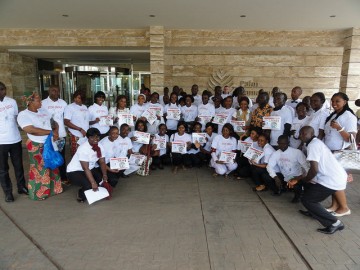
Hotel employees in Conakry, Guinea after a training on Ebola. ©CDC Global
My ‘movement’ to Freetown was scheduled to leave Bo Base at 1 pm. When I arrived there with my luggage, I was glad to see that my Ebola training partner from Amsterdam was coming along to help out in Freetown. Doctor Greg is an Australian ICU physician who has lived and worked in London UK for more than 30 years. He was originally sent to the EMC in Kailahun but they were closing because the epidemic has subsided in that area. Like me, he volunteered to help out in Freetown. The 3-hour road trip went quickly. There were many Ebola checkpoints along the way but the MSF Land Cruisers are allowed to pass without delay or inspection. We saw a motionless body along the side of the road and turned back to inform the police at the previous checkpoint. We are not permitted to stop for accidents or become involved in incidents to avoid the risk of exposure to blood and body fluids. We arrived in Freetown at 4 pm, received a brief orientation and were escorted to our rooms at the Roy Hotel where the OCG staff have their rooms.
Freetown is under ‘Ebola lockdown’. Shops and businesses have a 6 pm curfew during the week, a noon curfew on Saturday, and everything is closed on Sunday. The Roy is a nice hotel on the Atlantic Ocean with a seaside restaurant where I had enjoyed fresh lobster 3 weeks ago on my way to Bo. Greg and I unpacked and went down to the restaurant for dinner and a beer. Around 9pm, the hotel manager (Lebanese, of course) informed us that the other MSF-ers were on the terrace. Greg and I went out and introduced ourselves as the reinforcements from OCA. Everyone pleasantly murmured hello but they looked really beat. When I enquired at what time we leave the hotel for the EMC, their answer was 6:15 am. Hmm. When I asked if they had all just returned from the EMC at 9 pm, their answer was yes. Without thinking, I blurted out “oh shit!”
The hardest part
Most of the care for EVD patients is supportive nursing care provided by national and expat nurses – feeding, oral hydration, cleaning, dressing, wound care, comforting, giving oral meds and taking temperatures. The expat doctors and the CHOs (community health officers – similar to physician assistants) start and stop intravenous fluids, place and remove intravenous cannulas, draw blood, assess and monitor the clinical condition, develop a treatment plan, prescribe medication and decide when to do a follow-up Ebola lab test. A follow-up Ebola blood test is done only after three days with no fever or symptoms, that is, when the patient appears ready for discharge.
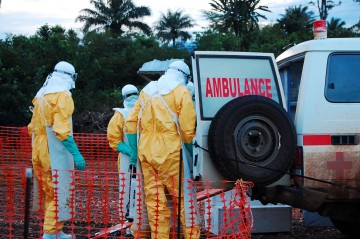
A team of hygienists try to move two patients who are too weak to move. In the five hours that it took for the ambulance to reach the MSF Case Management Centre in Kailahun, one of the patients died. Access to care is heavily constrained due to a severe shortage in ambulances, lack of treatment centres in the country and a struggling surveillance system. As of the end of October 2014, MSF has received over 900 admissions of which some 616 have been confirmed cases. Over 280 survivors have so far been discharged from the centre in Kailahun. ©Fathema Murtaza, MSF
The hardest part for me is not the heat, the boredom, the PPE, the lack of an Ebola treatment or even the presence of disease, death and grief. The hardest part is deciding what role to take. It would definitely be easier and perhaps more rewarding to ‘just do it’ – deliver myself whatever care or intervention is needed for each patient and let the local staff watch and learn. That approach might have a discernable effect on individual patients but not much of an impact on the general epidemic or in building capacity among Sierra Leonean health care workers. By the Super Bowl, I will be long gone and they won’t. The urgency of Ebola demands the most vertical of all initiatives – a one-disease program. In such a situation, the learning opportunities are scarce. My tendency is usually to provide support and guidance when necessary to the national staff as they deliver the direct care. But, it is always difficult to know what each one can do efficiently, where each one needs help and what each one cannot do at all. I’ll figure it out eventually.
When Ebola retreats into the jungle from whence it came, the health care system in all three Ebola-affected countries will need to be rebuilt from the ground up. If the donors and NGOs stay on to support this process, maybe that system will be better than before. It could hardly be worse. Everything is “no touch.” We don’t even do malaria rapid tests anymore because of the risk from blood and sharps. Sierra Leoneans rarely touch each other these days and expats are instructed never to touch another person unless in PPE and to avoid touching inanimate objects as well. Even in the MSF compound, we do not touch each other unless by accident. In dealing with patients at the staff clinic, at triage and at admitting, we take a verbal history from 2 metres away, separated by 2 fences. A profession in which the goal is a specific diagnosis and an individualized treatment based on history, physical exam, lab and X-ray has been reduced to an impersonal guessing game. I don’t disagree with this but it does feel strange.
I don’t want a lot for Christmas
Happy holidays: http://www.takepart.com/article/2014/12/25/aid-workers-around-world-working-holidays
Heart of darkness
The Bo EMC compound is an impressive and foreboding community encompassing around 30 acres just beside the main road that travels east from Bo to Kailahun. The Kailahun region is where the outbreak began and where MSF established their first Sierra Leone EMC. The epidemic is believed to have started in a small village with a young girl (unceremoniously referred to as “Patient 0″) in the Gueckedou region of Guinea that borders Foya in Liberia and Kailahun in Sierra Leone.
The Bo EMC compound is completely surrounded by a high fence with two guard stations. Immediately inside is a large MSF supply tent (in MSF lingo, a ‘rubhall’) that is next to six cottages; the middle four have been taken over by MSF as offices. The 1st is a CDC Ebola testing laboratory and the 6th is a private residence. Behind the offices are a huge water tower and a helicopter pad that has been located a bit too close to the patient tents, such that everything and everyone gets blown around whenever a copter lands. Behind the helicopter pad is the EMC itself surrounded by a second, inner fence that is meant to provide separation rather than confinement. The area within the inner fence is the EMC itself – divided into a low-risk zone and a high-risk zone. The low-risk zone comprises dressing rooms, a nursing station, a pharmacy, a dressing, and an undressing area, several supply tents and a laundry, bathroom, and kitchen. The high-risk zone is separated by a third fence and contains the heavily contaminated areas – the triage area, the ambulance entrance, 4 patient tents and the morgue. Bo has three rubhalls for confirmed Ebola viral disease (EVD) patients and one smaller tent (in MSF lingo, a ‘trigano’) for suspect and probable EBV patients awaiting the results of their Ebola lab test. The confirmed tents each contain 32 beds in 8 cubicles; 4 beds/cubicle. The suspect/probable tent has 8 beds.
There are four connections between the high-risk and low-risk zones – the discharge shower, the morgue exit, the dressing (donning) room, and the undressing (doffing) room. When patients are discharged, they have a thorough shower in the discharge shower room, they receive new clothes (all of their possessions are burnt or buried) and they are serenaded by songs and drums as they dance out of the EMC. In the morgue, dead bodies are thoroughly decontaminated with chlorine and zipped into a body bag. The white, plastic, non-porous body bags have the name of the deceased and his/her Ebola outbreak case number clearly noted in permanent red magic marker on the outside. A burial team that digs the grave, transports and deposits the body, fills in the grave again and marks the gravesite then whisks off the body. All of this backbreaking labor involving corpses that are heavily contaminated with a lethal virus is done over and over again, under the hot sun, in partial PPE and without complaint. One doesn’t have to look far to find unsung heroes in this tragic situation. The ambulance drivers are another.
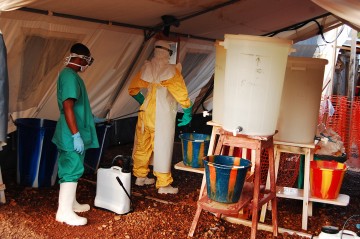
A hygienist steps in to the undressing tent to begin removing multiple items of protective clothing. The sprayer (left) guides the often exhausted colleague step by step through the undressing process. The protective layers can create stifling conditions that are difficult to withstand for too long. To avoid overheating and fatigue, staff working in the high risk zone must limit the time they spend in the isolation ward. ©Fathema Murtaza, MSF
We ‘go in’ with a partner and we stay in visual range of each other for the entire time. The maximum time in PPE is 1 hour but at midday 30-45 minutes is enough. The undressing (doffing) procedure is controlled by doffing officers who guide us through each step. “Now, remove your mask.” “Now, wash your hands properly.” This is basically donning in reverse plus hand washing with 0.05% chlorine and PPE spraying with 0.5% chlorine between each step. We usually ‘go in’ twice per shift.
The low-risk and high-risk zones are only 2 metres apart. They are separated by a 3-foot high, orange plastic, see-through fence that allows for full visual monitoring of the high-risk zone and verbal communication between the two. For instance, a person in PPE in high-risk can shout across that fence for clothes, a blanket(!), ORS (water mixed with oral rehydration salts) or a medication that can be thrown to them across the fence. Amazingly, nursing rounds occur every 2-3 hours right through the hottest part of the day and all night long.
There are 0.5% chlorine shoe-spraying stations and 0.05% chlorine hand-washing stations everywhere. The soles of the our shoes must be sprayed and our hands washed every time we enter or exit anything – offices, kitchens, bathrooms, compounds, and the low-risk zone. I do not find the chlorine toxic to my hands (except for turning my nails yellow) but I am just recovering from a chlorine chemical burn of my upper and lower eyelids. Luckily, my eyes were spared. I wasn’t aware that the skin of the eyelids was so sensitive. It feels and looks just like a sunburn and I am in the peeling stage. Happily, I didn’t miss any work.
A day in the life
My day usually starts around 6:30 am and I don’t need an alarm clock. A local choir of roosters fills that niche. A bucket shower with cold water reliably rids me of all remnants of drowsiness and I trundle off for breakfast at the group kitchen. The offerings at our morning repast include coffee (instant Nescafe, of course), milk (sometimes liquid, sometimes powder), cereal (mainly corn flakes), local bread (similar to an elongated hotdog bun but delicious), butter, jam, Laughing Cow ‘cheese’, yogurt and Nutella™ We sometimes have those individually packaged single slices of orange-colored cheese that my son Eddy once told me were one molecule away from plastic.
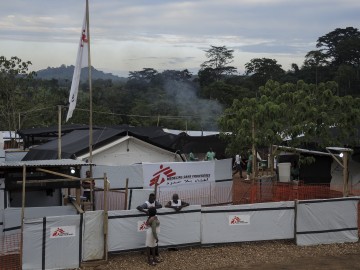
The Ebola Management Centre in Kailahun, Sierra Leone. The capacity was extended to 72 beds in August. ©Magali Deppen, MSF
After morning rounds, I don my PPE and enter the EMC patient tents around 9 am with a community health officer (CHO) to attempt specific tasks such as placing IV cannulas, starting or stopping IV fluids, giving morphine, assessing clinical status especially hydration, and sometimes to declare a death. I myself haven’t declared a death yet and I am not looking forward to it. Usually, we can complete our tasks within an hour but we have to keep track of the minutes and each other. If sweat streams out of your surgical gloves when you raise your hand or if your boots begin to emit sloshing sounds as you walk, that is the time to check the clock. They say there is no emergency when dealing with Ebola patients and, strange as that sounds, it is good advice to move slowly and act deliberately. When you hurry, you are more likely to put yourself and others at risk.
After my first entry, I head straight for the fridge in the pharmacy to grab a litre of filtered water and I plop down on a plastic chair in my soaked scrubs. Initially, it’s hard to focus my mind on what has just happened, and not happened, but after 10 minutes I can report my successes, failures, findings, and recommendations to the other expats and to the Sierra Leonean nursing team leader. Before my second and final entry around noon, I have time to admit new patients, to discuss cases, to check the useful and practical MSF handbooks for guidance, and to rehydrate. My second entry is similar to my first but, due to the time of day, it is much hotter and somewhat shorter. At around 10 am, the day shift arrives (an expat doctor and an expat nurse) and at 2 pm the afternoon shift gets there. We have hand-over rounds at 2:30 pm. I have to admit that I glad to go home and get some R&R before my next assignment. However, the younger doctors (Ben from Holland and Christophe from Germany) seem never to get tired and they often come to the EMC in their free time looking to do something. And, they consume enormous amounts of food and beer. I guess I was like ‘back in the day’.
In the evening, we usually gather around the pool, have dinner together, quaff a few beers, listen to someone’s iPod playlist, discuss the events of the day, and compare past missions. These impromptu get-togethers are one of the things that I like the most about MSF. The only downside is that so many MSFers smoke!
They say a picture is worth a thousand words…and it’s easier!
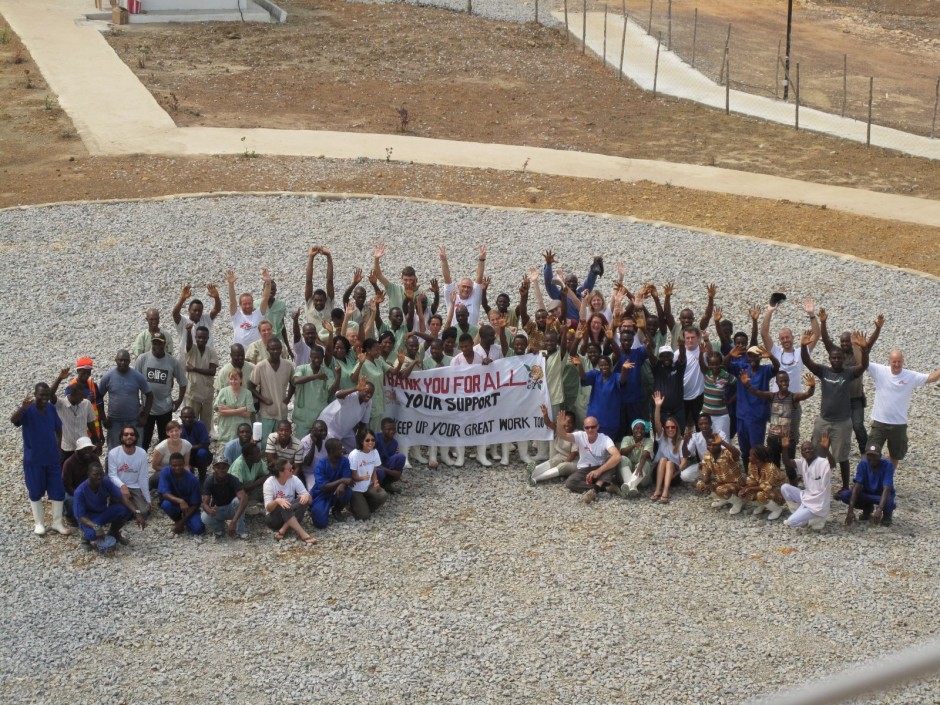
Bo EMC picture from Dr. Mike Rekart
Human traces
It’s Saturday, December 13th and I’m on the afternoon shift – 2-10pm – but I’ll go to the EMC at noon for a group picture on the helicopter pad. Several MSF projects around the world have sent along pictures of their group with good wishes to MSF – Bo and we are reciprocating. It is cloudy right now and hope it stays that way. We have five doctors and one physician clinic manager at the Bo EMC – three from Holland, one from Germany, one from England, and me. The five doctors rotate between morning shift (8am-3pm), day shift (10am-5pm), afternoon shift (2-10pm) and the MSF staff clinic (9am-2pm). After eight days and eight shifts in a row, we get a day off. The Bo project is now operated by MSF Holland but we took over for MSF Belgium who were here for 10 years doing pediatric care. MSF delivers health care to all of our national staff, all of their former national staff and their families. Most care is done by national doctors working for MSF and one of the expats attends the daily staff clinic for advise and to make sure nobody with possible Ebola gets overlooked.
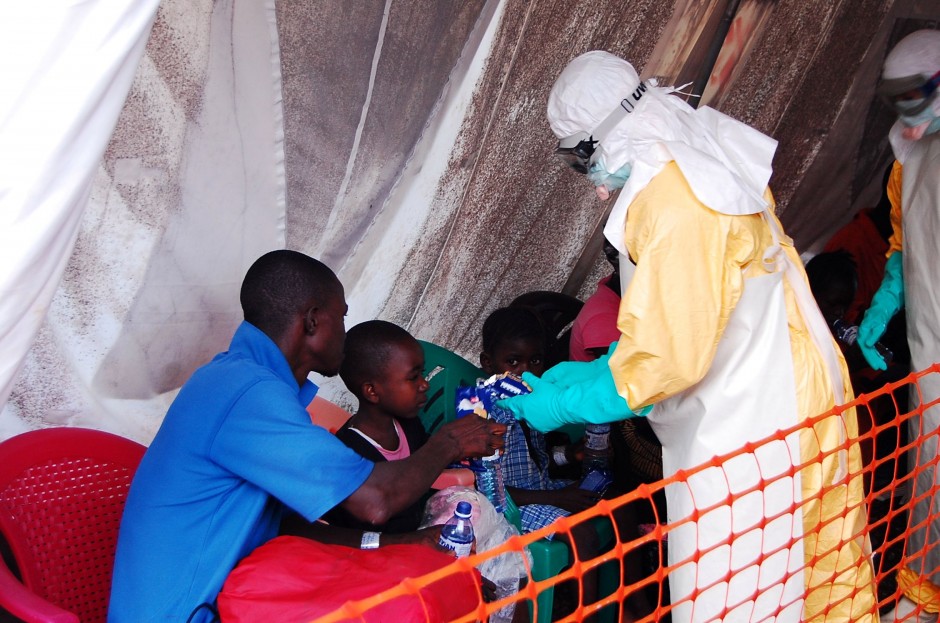
Patients admitted to MSF's Ebola Case Management Centre enter a triage tent. Here medical teams try to determine the severity of their symptoms and assess their contact history. Patients are provided water and snacks and a chance to catch their breath after their long and difficult journey on very poor roads. ©Fathema Murtaza, MSF
My first experience as the day shift doctor went fairly well yesterday. I admitted three patients around 4 pm. My first admission was a one week-old newborn with Ebola whose mother had died of Ebola in childbirth – Borbor Winston. He appears to have no family or at least no one was accompanying him except for two unrelated Ebola patients from the same hospital, in the same ambulance. He weighs around 2.5 kg and seems to be in good condition. His only known signs/symptoms are fever and hiccups. The latter is a bad prognostic sign. As far as I know, only one child born with Ebola has ever survived so there is little hope for him, but he is feeding well and who knows what will happen. Ebola in pregnancy is devastating. Pregnant Ebola patients usually have a miscarriage and the products of conception have extremely high Ebola viral loads similar to a corpse.
We also admitted three sisters with Ebola – 15, 11 and 9 years old. They are very cute and seem to be doing well. They are sleeping in the same cubicle and are always together. It is impressive the way the adults in the EMC take care of the children and each other whether they are related or not. For example, we have a 15 month-old baby girl who recovered from Ebola a couple weeks ago and who is living in a small MSF house just outside the EMC but still inside the gates. His mother died yesterday and he is being taken care of by two women who recovered from Ebola but lost children to Ebola themselves.
When times become desperate, I am impressed how so many people step up to the plate.
I’m goin’ in
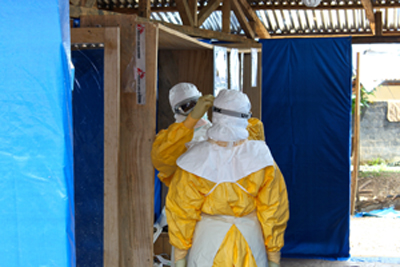
Scene from an Ebola treatment facility run by Médecins Sans Frontières (MSF) in Guéckédou, Guinea. Source: United Nations
It is 8 pm on Thursday, December 11th and I am sitting around the MSF compound with 20 well-deserved ‘persons of the year’ participating (but not much) in yet another evening medical meeting. We’ve had an evening meeting four days in a row. So far, I’ve been into the EMC in full Personal Protective Equipment (PPE) four times. My first entry/exit was definitely the most emotionally stressful but strangely not as difficult physically as I expected. I was able to see pretty well through the goggles because of the new defogger that we are using and I didn’t get dizzy or faint. The primary stress was worrying about getting dizzy or faint rather than actually getting dizzy or faint. I definitely poured out a great deal of sweat and was very dehydrated… but I rehydrated quickly. The exit procedure was interesting. One has to correctly perform all sorts of bodily contortions to remove the various layers of PPE equipment without touching the contaminated outside surfaces in front of doffing officers who seem to get special pleasure telling expat doctors that they are not doing it right. Between each and every procedure, you have to thoroughly wash your hands with 0.05% chlorine. The chlorine solution is really irritating. If you put your face directly over the solution while washing, your eyes, nose, lungs, and mouth react strongly. Splashing cool water on my face at the end of this tortuous regime felt really, really good!
So, what can be accomplished in EMC entries of less than 1 hour for extremely ill patients that cannot be properly examined or tested and who have a disease with no treatment and 70% mortality? That’s a good question. From the population and public health point of view, I think that the primary benefit is isolation – removing Ebola infected patients from the general population so they can no longer infect others and propagate the epidemic. From a clinical point of view, most of the interventions are supportive nursing care such as cleaning the patients, encouraging and assisting them to eat and take fluids, changing dressings, hanging new bags of IV fluids, making sure they take their oral medications and providing compassion and support.
But, the Ebola patients also have specific medical needs that usually fall into the category of ‘doctor interventions’. These include an initial assessment of the seriousness of the clinical condition and grading patients on a scale of 1 to 5. The doctors also evaluate for coexisting medical conditions, especially those that require treatment. For instance, in addition to the 24 standard Ebola symptoms such as diarrhea and vomiting, we currently have patients who also have bedsores, conjunctivitis, vaginal discharge, post-partum vaginal bleeding, persistent fevers, severe cough, pleurisy, malaria and Lassa Fever. The doctors also treat everyone according to MSF guidelines for malaria with Co-artem, provide a broad-spectrum antibiotic, usually cefixime) to all admissions and prescribe treatment for diarrhea, vomiting, pain and anorexia as needed. Patients who are Ebola grade 5 also require morphine for palliative care. Everyone also gets multivitamins and most receive plumpy nut (a peanut-based, high calorie, nutritional supplement). There are also several children who need special attention.
Drawing blood and starting IVs are done by the expats and the 1 national staff member trained and certified for these risky interventions. The only blood test we perform is the Ebola PCR but female patients often have a urine pregnancy test at some point. We have a CDC lab onsite for the PCR. Deciding when to start an IV and successfully inserting an intravenous cannula for dehydrated and sometimes agitated patients while dressed in full PPE is obviously a very big deal. Sierra Leoneans have very dark skin so this makes visualization of veins that much harder. The Ebola viral load in blood is extremely high so this procedure can be dangerous. I am told that the likelihood of acquiring Ebola after an accidental needle stick is near 90%. Many of the national staff have performed these procedures prior to Ebola and there is some resentment that they can no longer do this. We have 9 patients on IV fluids at the moment and this can be a very important intervention to treat the severe dehydration that is often present. Many patients cannot take oral fluids because of persistent vomiting.
Well, my training stopped yesterday and today I will be the only doctor on the ‘day shift’ – 10 am to 6 pm. We had 57 patients yesterday and we are expecting 6 new admissions today. I’m pretty nervous but there are lots of skilled national staff and nurses around to hold my hand.
More later….
Point of no return
I arrived at my Ebola assignment in Bo, Sierra Leone on Monday, December 8th. The weather is very hot (35-40°C) and humid but the countryside is interesting and the people are nice. There are around 40 international staff (expats) here at Bo and 500+ national staff (Sierra Leoneans). The Bo Ebola Management Centre (EMC) is a couple of kilometers outside of town and there are 100 inpatient beds in a secure, double-fenced and guarded compound. Currently, we have 60 patients including 11 children and 1 infant. There are several family groups in the EMC, often a mother, father and child. The mortality rate is around 50% and most patients stay 5-10 days. There is a short party each time someone recovers and leaves. They even get an “Ebola Free” government certificate.
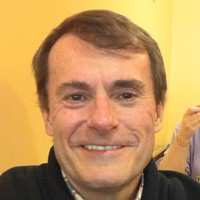
Dr. Michael Rekart
The living arrangements are reasonable. MSF has taken over a small country inn where most people stay and eat and where there are frequent medical meetings. There are 4 other houses for overflow and for visitors. We have electricity most of the time, fans and clean water that is not heated … but who needs that! The food is good so far and there is plenty of beer. I’ll probably gain weight. Fortunately, we have regular internet. Most expats are here for 4-8 weeks but some of the support staff are here for a longer period. I suspect the time will fly by and I will learn a lot.
Take care
Mike